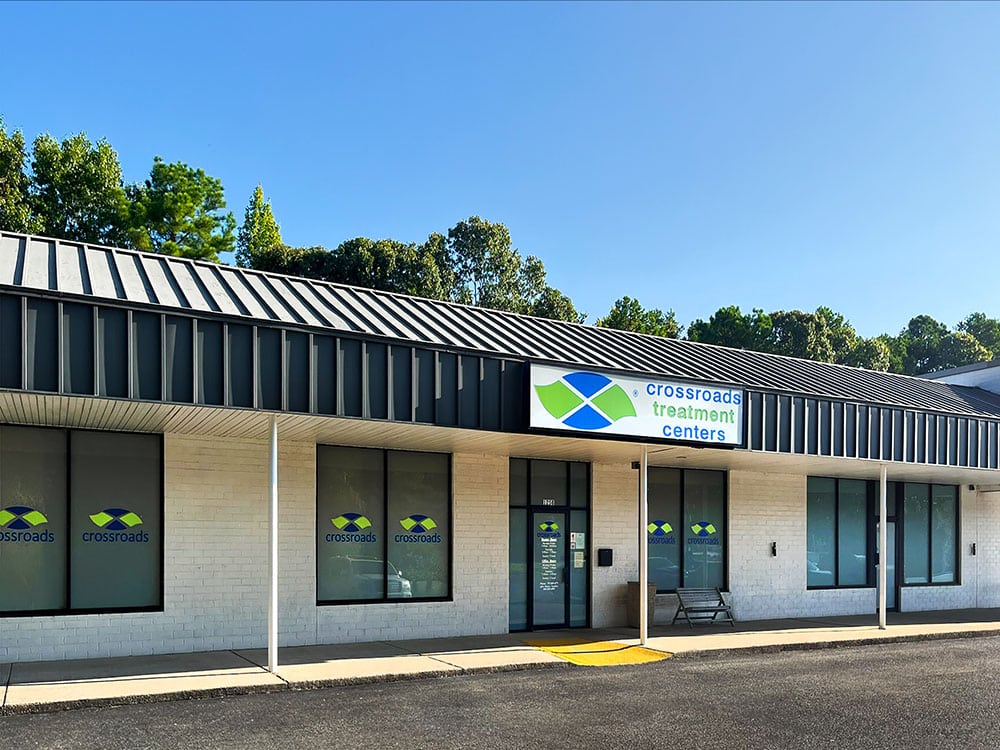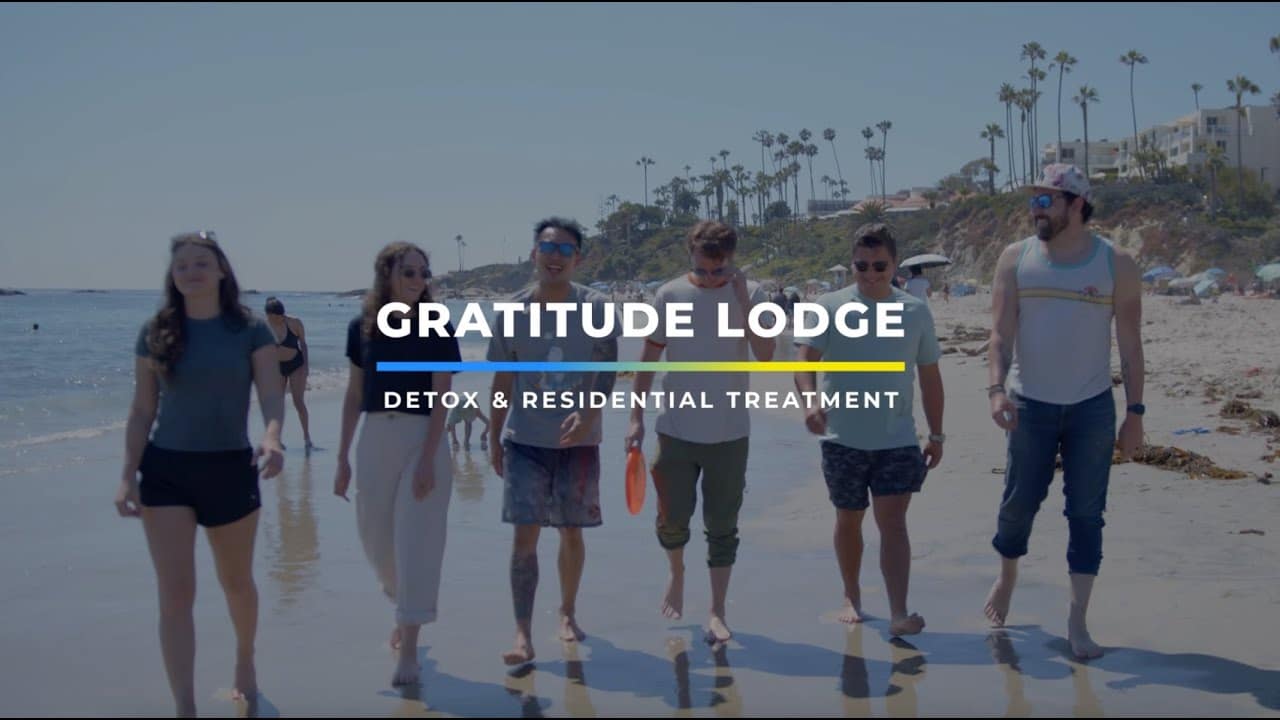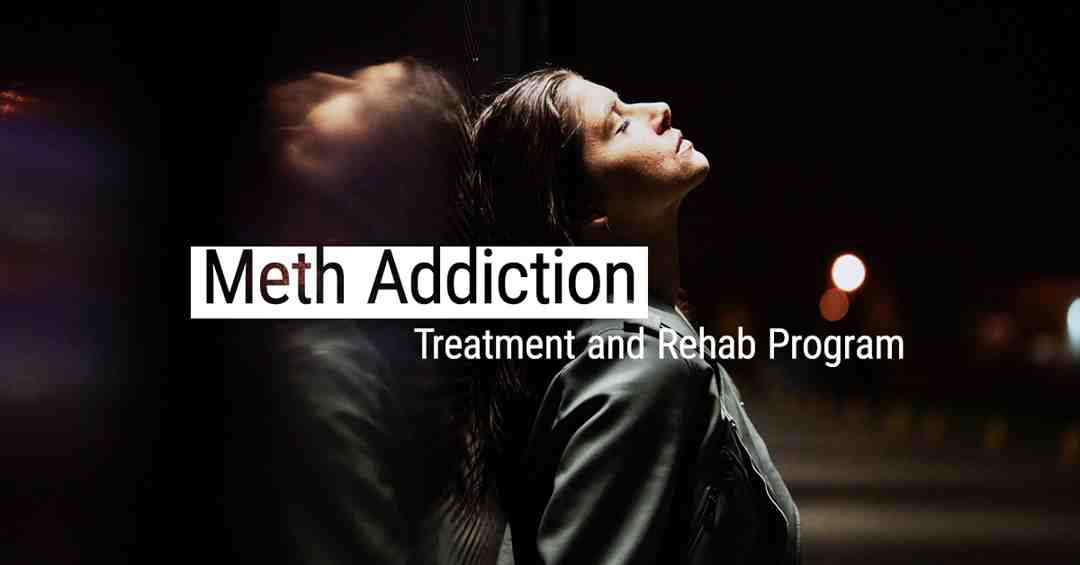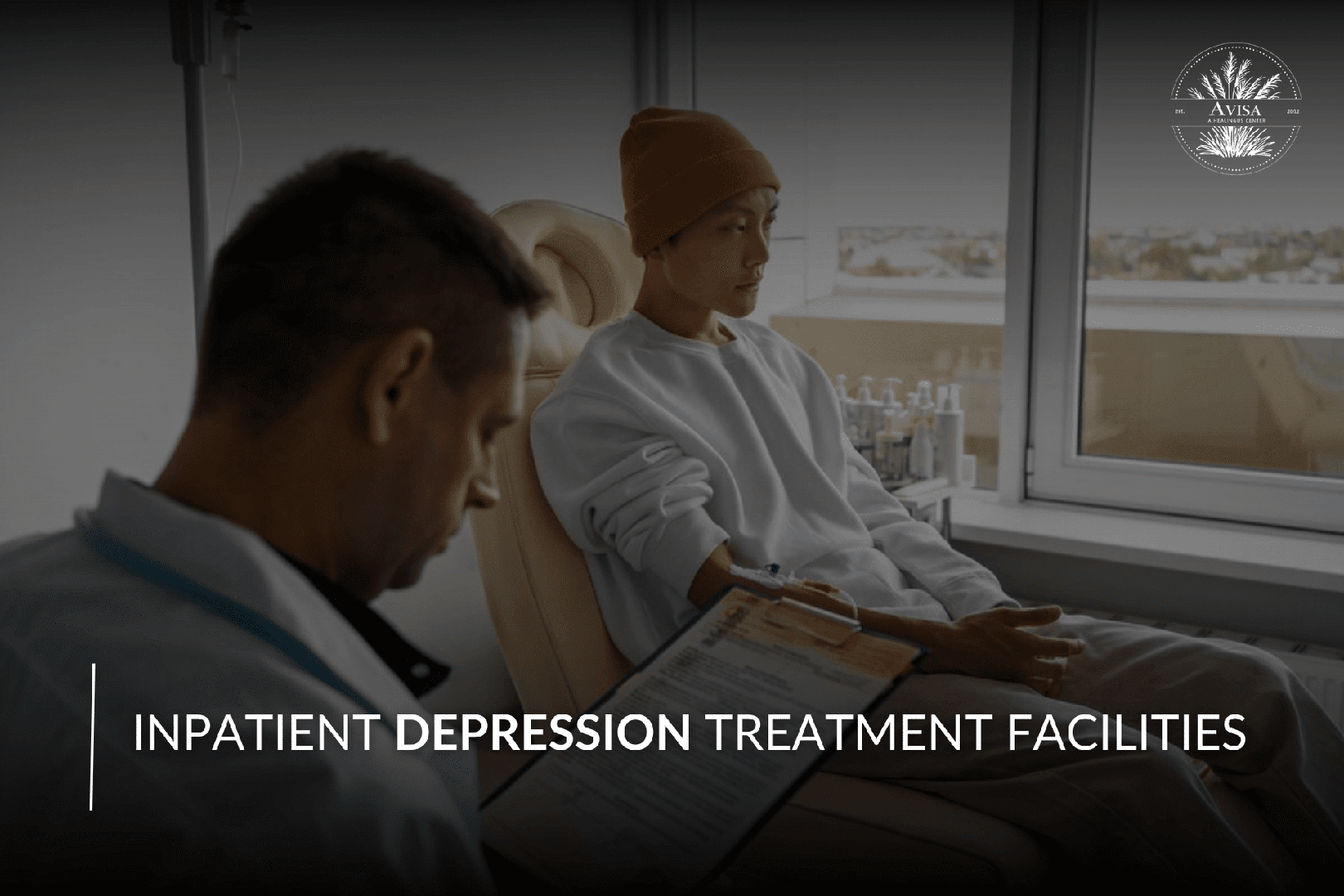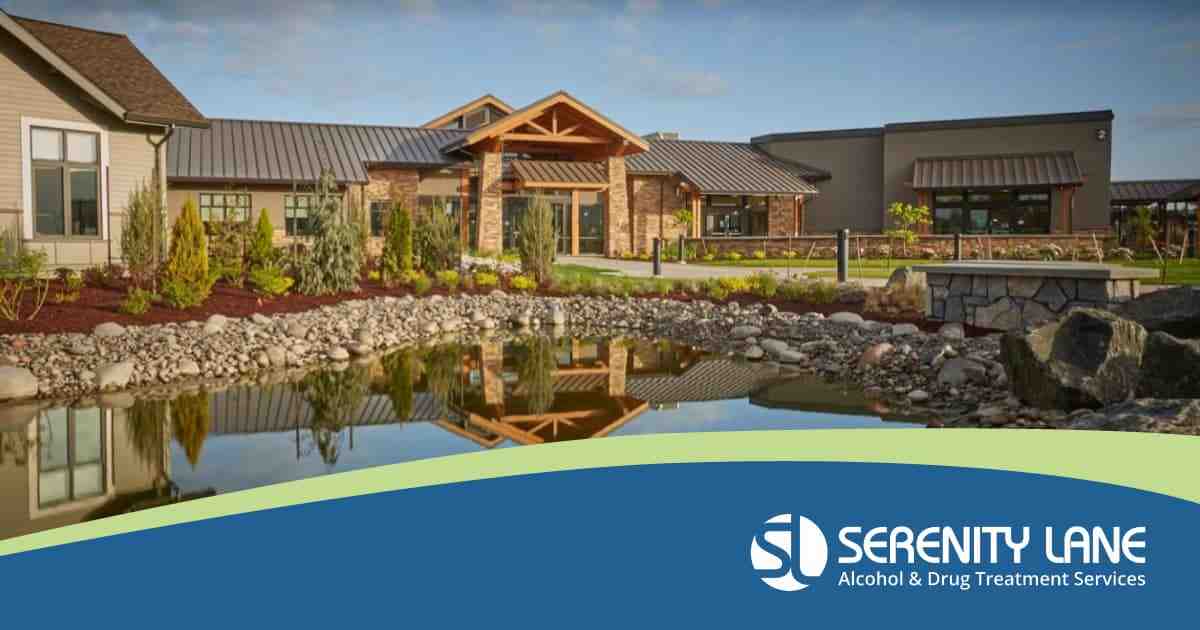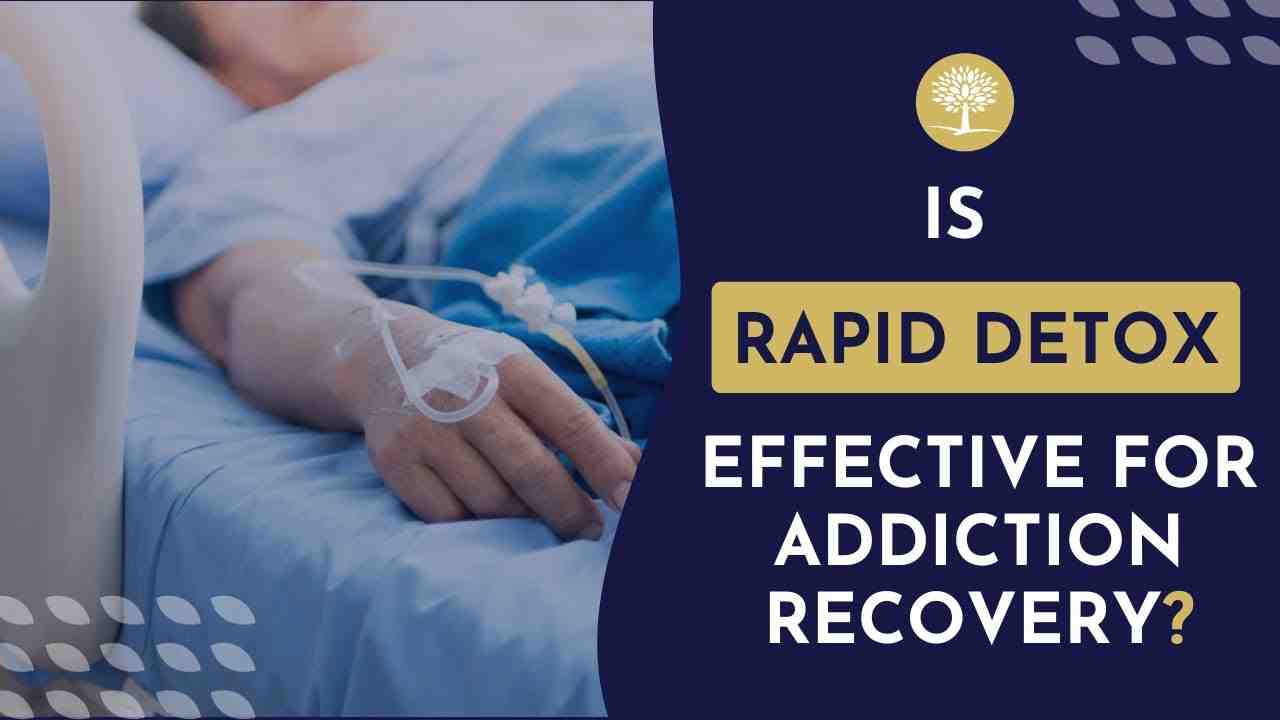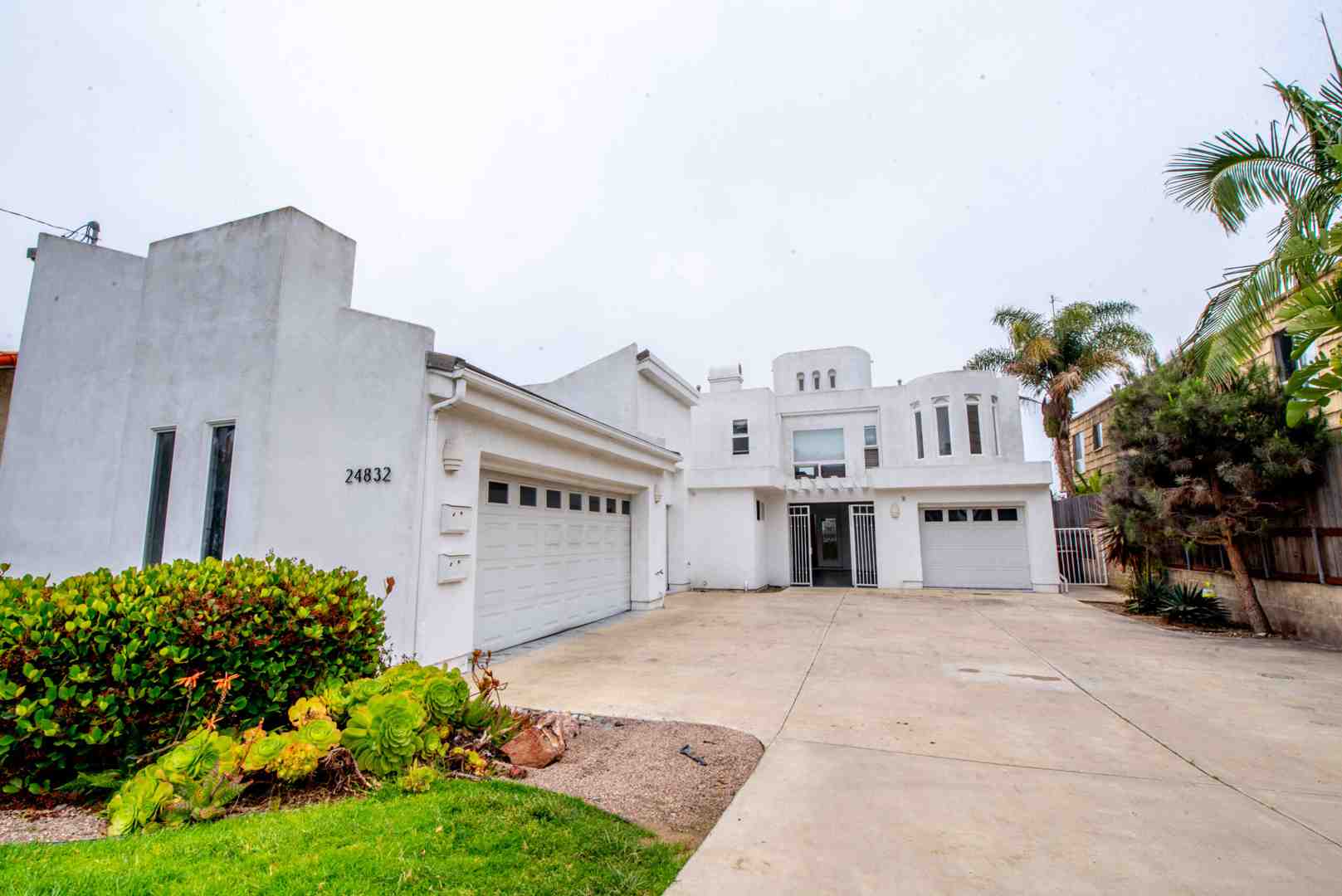
Why Orange County Stands Out for Addiction Treatment
Orange County rehab centers offer some of the most advanced addiction treatment in the country, with 173 evaluated facilities providing care from detox to long-term recovery. These centers blend evidence-based therapies with Southern California’s healing environment, making it an ideal place for recovery.
However, choosing from so many options can be overwhelming. The stakes are high; in 2020, over 1,000 people in Orange County died from drug and alcohol overdoses. Finding the right treatment isn’t just important—it’s life-saving.
Quick Overview: What Orange County Rehab Centers Offer
| Level of Care | Description | Typical Duration |
|---|---|---|
| Medical Detox | Medically supervised withdrawal management with 24/7 support | 7+ days |
| Inpatient/Residential | Structured, immersive treatment in a safe environment | 30-90+ days |
| Partial Hospitalization (PHP) | Intensive daily therapy without overnight stays | 5 days/week |
| Intensive Outpatient (IOP) | Flexible therapy sessions around work/school | 3-5 days/week |
| Outpatient Care | Ongoing support for long-term recovery | Varies |
Many centers accept major insurance, making quality care accessible. Whether you need help with co-occurring mental health disorders, trauma, or programs for specific groups like veterans, Orange County has an option.
At Addiction Helpline America, we provide free, confidential guidance 24/7. Our specialists help you steer the complex landscape of Orange County rehab centers to find a program that matches your unique needs.
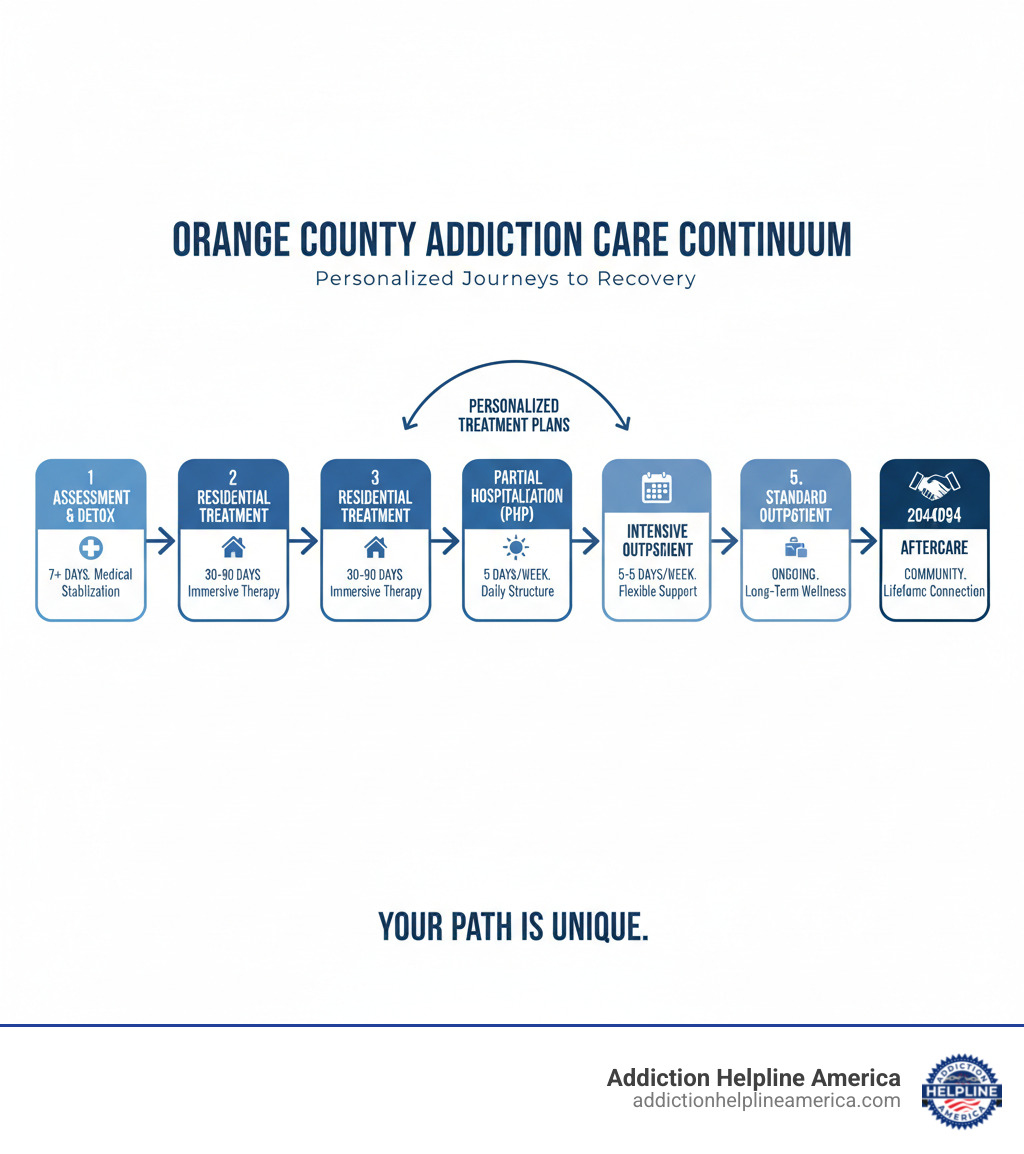
Learn more about Orange County rehab centers:
Why Choose Orange County for Addiction Recovery?
When you’re fighting addiction, your environment plays a crucial role. Orange County offers a unique combination of natural beauty and advanced clinical care that supports healing.
The serene coastal setting of places like Newport Beach and Laguna Beach provides a natural therapeutic backdrop. The ocean has long been recognized for its healing properties, and many Orange County rehab centers integrate this into their programs. Outdoor activities like surfing, hiking, and beach walks are not just distractions; they are powerful tools for building mental and physical resilience.
Beyond the scenery, Orange County’s strength lies in its high concentration of quality treatment options. With 173 alcohol and drug rehabs evaluated by our team, the variety is immense. You can find centers specializing in trauma-focused care, dual diagnosis treatment, and programs for nearly any specific need.
The local recovery community is another significant advantage. With numerous AA and NA meetings available, there is a strong network of peer support that extends long after formal treatment ends. This, combined with the area’s accessibility for family therapy and visitation, creates a comprehensive support system for lasting recovery.
Understanding the Levels of Addiction Care
Addiction recovery is a journey, not a single event. Orange County rehab centers offer a continuum of care, allowing treatment to be custom to your specific needs at each stage. The right level of care depends on factors like the severity of substance use, your medical history, and any co-occurring mental health conditions.
-
Medically Supervised Detox: This is the first step for those with physical dependence on substances like alcohol, opioids, or benzodiazepines. Withdrawal can be dangerous, and detox provides 24/7 medical monitoring to ensure safety and manage symptoms. It typically lasts seven or more days.
-
Inpatient/Residential Treatment: This involves living at the facility for 30, 60, or 90 days. It offers an immersive, structured environment away from daily triggers, with 24/7 support, individual and group therapy, and educational workshops. It’s an intensive approach that builds a strong foundation for recovery.
-
Partial Hospitalization Program (PHP): Often called “day treatment,” PHP provides intensive therapy for several hours a day, five days a week, while you return home or to a sober living environment at night. It offers a high level of support with more flexibility than inpatient care.
-
Intensive Outpatient Program (IOP): IOP offers more flexibility, with therapy sessions held three to five days a week for a few hours at a time. It’s ideal for those transitioning from a higher level of care or for individuals who need to balance treatment with work or school.
-
Standard Outpatient Treatment: This involves weekly therapy sessions and support group meetings. It’s best for those with less severe addictions or as a long-term maintenance plan after completing more intensive programs.
-
Aftercare and Sober Living: Recovery continues long after a program ends. Effective aftercare includes ongoing therapy, support groups like AA/NA, and relapse prevention planning. Sober living homes offer a structured, substance-free environment to practice new skills with peer support.
At Addiction Helpline America, we help you determine which level of care is the right starting point for your recovery journey.
What to Look For: 7 Hallmarks of the Best Rehab Centers
With so many Orange County rehab centers making similar promises, it can be hard to know which ones deliver quality care. We’ve identified seven key hallmarks that separate exceptional treatment centers from the rest. Use these criteria to guide your search.
1. Comprehensive Dual-Diagnosis Treatment
Addiction often co-occurs with mental health conditions like anxiety, depression, or PTSD. In fact, about 50% of people with substance use disorders also have a co-occurring mental health condition. The best centers offer integrated care that treats both issues simultaneously with a coordinated team of therapists and psychiatrists, rather than addressing them in isolation. For more information, see the National Institute of Mental Health’s guide on the link between substance use and mental health.
2. Evidence-Based Therapeutic Modalities
Reputable centers build their programs on scientifically proven therapies. Look for treatments like:
- Cognitive Behavioral Therapy (CBT): Helps change destructive thought patterns.
- Dialectical Behavior Therapy (DBT): Teaches emotional regulation and mindfulness.
- Eye Movement Desensitization and Reprocessing (EMDR): Helps process traumatic memories that may fuel substance use.
These therapies should be offered in individual, group, and family settings for a comprehensive approach.
3. Personalized and Holistic Approaches

A one-size-fits-all plan doesn’t work for addiction. The best Orange County rehab centers create individualized treatment plans and often have low client-to-staff ratios for personalized attention. They also accept holistic therapies that treat the whole person—mind, body, and spirit. These can include:
- Nutrition counseling to restore physical health.
- Mindfulness and meditation to manage cravings.
- Yoga and exercise to reduce stress.
- Surf therapy, which uses the healing power of the ocean.
4. A Full Continuum of Care
Recovery is a process with different stages. A top-tier center provides a full continuum of care, offering seamless transitions from medical detox to residential treatment and then to outpatient programs (PHP, IOP). Great programs emphasize robust aftercare planning from day one, including relapse prevention strategies, alumni programs, and connections to community support groups to ensure long-term success.
5. Proper Licensing and Accreditation
Licensing and accreditation are non-negotiable markers of quality and safety. In California, facilities must be licensed by the State Department of Health Care Services (DHCS). Additionally, look for national accreditation from respected bodies like The Joint Commission (JCAHO) or the Commission on Accreditation of Rehabilitation Facilities (CARF). These credentials prove a center meets high national standards for clinical care, staffing, and patient safety.
6. Specialized Programs for Diverse Needs
Effective treatment recognizes that different people have different needs. The best Orange County rehab centers offer specialized tracks for specific populations, such as:
- Gender-specific programs for men and women.
- Programs for veterans and first responders that address service-related trauma.
- Age-specific care for adolescents and young adults.
- Programs for executives or individuals with co-occurring eating disorders.
7. A Supportive and Healing Environment
Your physical surroundings can significantly impact your recovery. The best centers are intentional about creating peaceful, safe, and comfortable environments. This includes comfortable amenities, nutritious meals, and a positive peer community. Orange County’s coastal location provides a unique advantage, offering settings away from triggers where you can focus completely on healing.
Navigating Costs and Insurance for Treatment in Orange County
Concerns about the cost of treatment should not be a barrier to getting help. Understanding your financial options for Orange County rehab centers is more straightforward than you might think.
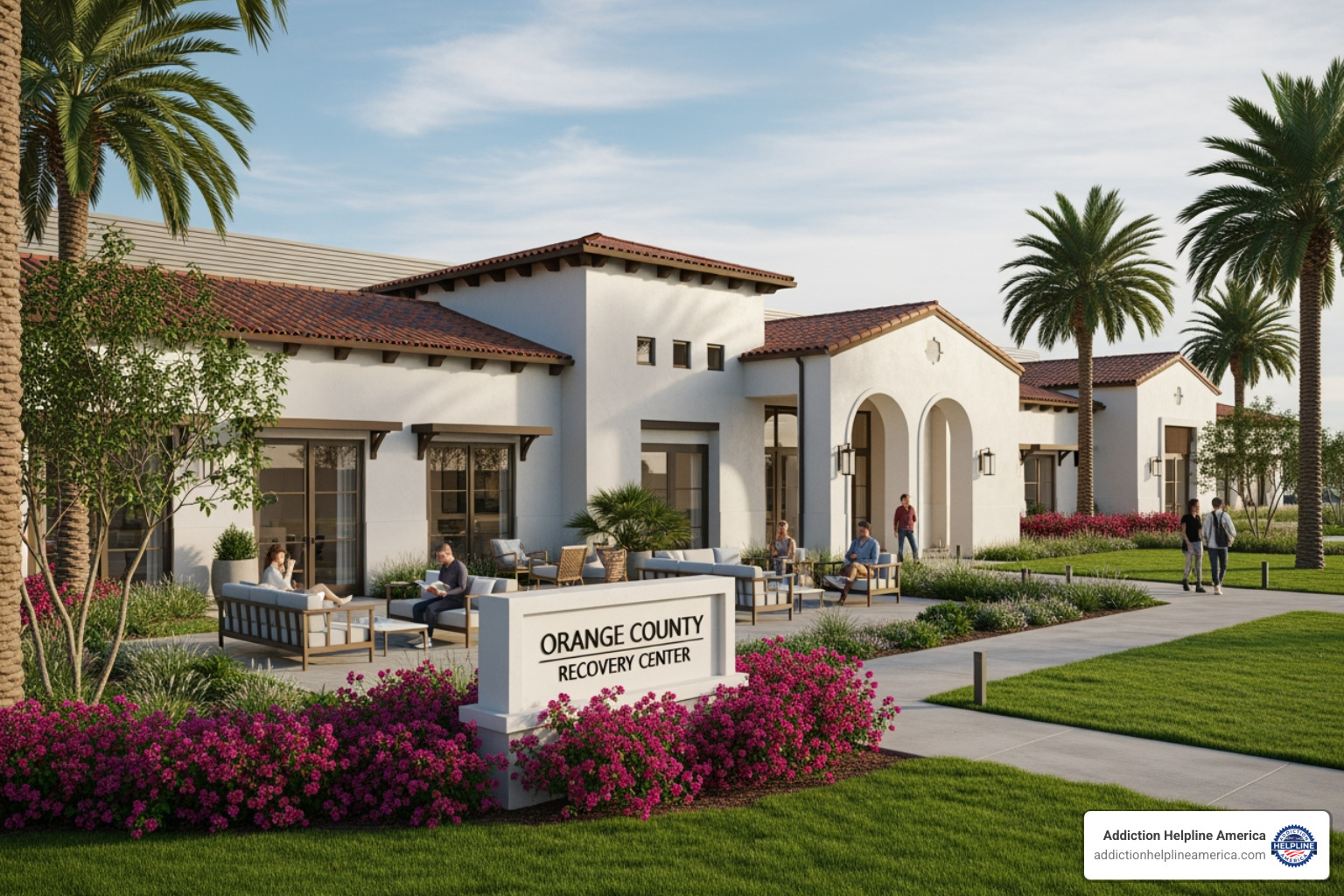
How Much Does Treatment Cost?
Costs vary based on the level of care and facility. For example, outpatient detox may cost around $1,200, while residential inpatient services can exceed $10,000. However, most people do not pay these full amounts out-of-pocket.
How Insurance Can Help
Thanks to mental health parity laws, most health insurance plans are required to cover substance use disorder treatment. Your coverage depends on your plan:
- PPO plans offer more flexibility in choosing providers, including out-of-network options.
- HMO plans typically require you to use in-network providers for the lowest costs.
Most reputable Orange County rehab centers accept major insurance plans like Anthem Blue Cross Blue Shield, Cigna, Aetna, and Humana. An in-network facility has pre-negotiated rates with your insurer, which usually means lower costs for you.
Verifying Your Coverage
Finding out what your plan covers is a simple, free process. At Addiction Helpline America, we can verify your benefits for you. Most rehab centers also offer this service, quickly determining your deductible, out-of-pocket maximum, and covered services.
Other Payment Options
If you have limited or no insurance, you still have options:
- Private pay offers the most flexibility.
- Sliding scale fees at non-profit centers adjust costs based on your income.
- Payment plans allow you to pay for treatment over time.
- Grants and scholarships may be available through various organizations.
- Medicaid and Medicare are accepted at 21 and 8 centers in Orange County, respectively, though waitlists can be longer.
Don’t let financial worries stop you. Our team can help you explore every option to make treatment affordable.
The Admissions Process: Your First Step to Recovery
Making the decision to seek help is a courageous first step. The admissions process at Orange County rehab centers is designed to be supportive and straightforward. Here’s what you can typically expect.
-
Confidential Phone Call & Assessment: It all starts with a free, confidential phone call to an admissions specialist. You can ask questions and share your story without judgment. During this call, you’ll complete a pre-admissions assessment covering your substance use history, medical background, and mental health concerns. This helps the team understand your needs.
-
Insurance Verification & Financial Planning: The admissions team will help you understand your financial options. They will verify your insurance benefits to clarify what your plan covers, including any co-pays or out-of-pocket expenses.
-
Comprehensive On-Site Evaluation: Upon arrival at the facility, you will undergo a thorough medical and psychological evaluation. This in-depth assessment by physicians and mental health professionals ensures your safety and is crucial for creating an effective treatment plan, especially if you have co-occurring disorders.
-
Customized Treatment Plan: Using the information from your assessments, the clinical team will create a personalized treatment plan. This roadmap is custom to your specific challenges, needs, and recovery goals.
-
Preparing for Your Stay: The admissions team will provide a packing list, which typically includes comfortable clothing and personal hygiene items. Facilities have rules about what to bring (especially electronics) to minimize distractions and help you focus on recovery.
Reaching out is a sign of strength. The admissions team at Addiction Helpline America and our partner facilities are here to guide you through every step of this process.
Frequently Asked Questions about Orange County Rehab Centers
It’s normal to have questions when considering treatment for addiction. Here are answers to some of the most common questions we hear about Orange County rehab centers.
How do I choose from the many Orange County rehab centers?
With 173 alcohol and drug rehabs in Orange County, the choice can feel overwhelming. Here’s how to narrow it down:
- Get a professional assessment. Talk to an addiction specialist, like our team at Addiction Helpline America, to determine the right level of care for your needs.
- Check for proper accreditation. Ensure the facility is licensed by the California DHCS and accredited by The Joint Commission or CARF. This is a key indicator of quality and safety.
- Verify your insurance. Most centers offer free insurance verification. Knowing your coverage and potential costs upfront simplifies the decision.
- Look for specialized programs. If you have specific needs (e.g., you’re a veteran, need dual diagnosis care, or prefer a gender-specific environment), find a program that specializes in treating people like you.
- Evaluate the treatment approach. Look for a blend of evidence-based therapies (CBT, DBT) and holistic options that treat the whole person.
What specialized programs do Orange County rehab centers offer?
One of the biggest advantages of seeking treatment in Orange County is the variety of specialized programs available. Many centers recognize that a one-size-fits-all approach is ineffective. Common specializations include:
- Gender-specific programs for men and women.
- Dual diagnosis treatment for co-occurring mental health conditions.
- Trauma-informed care using therapies like EMDR.
- Programs for veterans and first responders with staff trained in military culture.
- Age-specific care for adolescents and young adults.
- Luxury and executive programs for those needing privacy and professional flexibility.
- Pet-friendly programs, like the one at Asana Recovery.
How long is a typical rehab program?
Program length is highly individualized and depends on the severity of the addiction, co-occurring disorders, and personal progress. There is no single “right” answer, but here are some typical timeframes:
- Medical Detox: Usually 7 or more days, depending on the substance.
- Inpatient/Residential Treatment: Programs are commonly 30, 60, or 90 days. Research shows that longer stays, particularly 90 days, are associated with better long-term recovery outcomes.
- Outpatient Programs (PHP & IOP): These step-down programs can last for several weeks to a few months, providing structured support as you transition back to daily life.
- Aftercare: Ongoing support through therapy and support groups is a lifelong process.
The right duration is whatever gives you the strongest foundation for lasting sobriety. Our team at Addiction Helpline America can help you find Orange County rehab centers that offer the right intensity and length of care for your situation.
Conclusion: Find Your Path to Recovery in Orange County
Orange County is a premier destination for addiction recovery, combining world-class Orange County rehab centers with a naturally healing coastal environment. With over 173 facilities, the region offers a comprehensive range of services, from medically supervised detox to specialized programs that address the unique needs of diverse populations.
We’ve explored the hallmarks of exceptional care: integrated dual-diagnosis treatment, evidence-based therapies, personalized holistic plans, and a full continuum of support. However, the most important takeaway is that the “best” center is the one that aligns with your specific clinical, personal, and financial needs. Recovery is a personal journey, and your treatment should reflect that.
Whether you need a gender-specific program, trauma-informed care for veterans, or a flexible outpatient option, a match is waiting for you in Orange County. You are not alone in this struggle, and thousands have found lasting recovery here.
Hope is abundant, and it starts with the decision to reach out for help. At Addiction Helpline America, we are dedicated to being your partner on this journey. We offer free, confidential, 24/7 guidance to help you steer your options without pressure or judgment. We’ll verify your insurance, answer your questions, and connect you with a treatment center that truly fits.
Recovery is possible. You don’t have to have all the answers—you just have to be willing to take the first step. Let us help you find your path.
Find the right treatment center in Costa Mesa for your needs.
Our helpline is 100%
free & confidential
If you or someone you care about is struggling with drug or alcohol addiction, we can help you explore your recovery options. Don’t face this challenge alone—seek support from us.
Programs
Resources
Will my insurance
cover addiction
treatment?
We're ready to help
Find the best
drug or alcohol treatment
center
Are you or a loved one struggling with addiction? Call today to speak to a treatment expert.

